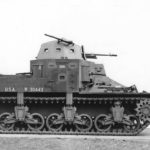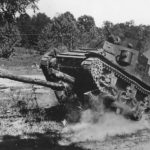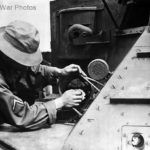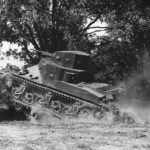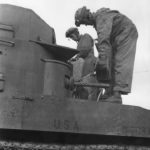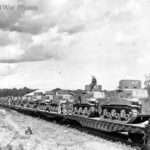M2A1 medium tanks during Maneuvers in 1941
Troops ferry M2 tank across Salt River at Fort Knox 1941
M2A1 30443
1st Armored Division M2A1 crushes a road block at Fort Knox 1941 2
M2 tanks of the 67th Regiment 1940
Flame gun E2 on M2 WD No. 30451
Maintenance crew working on M2 medium
Prototype T5 rear view
M2A1 tanks move thru Castor, Louisiana during maneuvers 1941
M2 30458 of the 67th Armored Regiment Luisiana 1941
M2A1 medium tank 1941
Flame thrower tank M2 medium No. 30451
1st Armored Division M2A1 crushes a road block at Fort Knox 1941
Crew from 2nd Armored Division, 67th Regiment refueling M2A1 1941
M2A1 Fort Benning 1940
Medium Tank, M2 30416
M2A1 of the 2nd Armored Division “Hell on Wheels”, June 1941
The Medium Tank M2, developed in the late 1930s, marked an important step in the evolution of U.S. armored vehicles. Derived from the T5 prototype (Phase I), the M2 was heavily influenced by the interwar tank designs and the lessons learned from early experiments in armored warfare.
Key Features of the Medium Tank M2
- Armament: The M2 was originally armed with a 37mm M3 gun in the turret, replacing the dual 37mm guns from the prototype. The secondary armament was extensive for its time, with:
- Two fixed .30 caliber machine guns in the front hull.
- Four sponson-mounted machine guns.
- Two antiaircraft machine guns. This heavy reliance on machine guns reflected the early 20th-century belief in the importance of anti-infantry firepower, a feature that was becoming less relevant with the advent of heavier armored and mechanized warfare.
- Armor: The M2’s armor was made from face-hardened plate, with thicknesses ranging from 1-1/8 inches on the front to 1/4 inch on the floor. This was relatively thin by later standards, as tanks increasingly faced threats from more powerful antitank guns.
- Powerplant: The M2 was powered by a 350 hp Wright air-cooled radial engine, which replaced the weaker engine in the T5 prototype. With a total weight of around 19 tons, this engine gave the tank a respectable power-to-weight ratio of 18.4 hp/ton, allowing for a top speed of 26 miles per hour. However, the narrow tracks meant ground pressure remained high at 18.8 psi, limiting off-road performance.
- Suspension: The M2’s suspension was typical of interwar designs, focusing more on road speed than the rugged mobility that later tanks would require. The track width, though increased to 13-1/4 inches, was still relatively narrow for a tank of its weight, contributing to the high ground pressure.
Production and Testing
Initial production of the M2 began in 1939 at Rock Island Arsenal, with 18 tanks authorized for the Fiscal Year 1939. The second production model was sent to Aberdeen Proving Ground for testing in August 1939. An additional 54 tanks were authorized for Fiscal Year 1940, but changes in the global situation and advancements in tank design halted further production. The design improvements and combat lessons from other nations showed the need for better armor and firepower, leading to further refinements.
Transition to the M2A1
The M2A1, an improved version of the original M2, incorporated several upgrades:
- Armor Protection: The armor was increased to 1-1/4 inches on all vertical surfaces, providing better protection against small-caliber weapons and early antitank guns.
- Turret Redesign: The M2A1 featured a new roomier turret with vertical sides, replacing the sloped walls of the original. This allowed for better crew ergonomics. The pistol ports were added for crew defense, and the turret hatch was moved from the rear to the roof.
- Improved Engine: The M2A1 received a more powerful 400 hp Wright R975 EC2 engine, improving the power-to-weight ratio to 19 hp/ton, although the maximum speed remained at 26 mph.
- Track Width and Ground Pressure: The tracks were widened by an additional inch, reducing the ground pressure to 15.3 psi, slightly improving the tank’s off-road capability.
- Gun Mount and Machine Gun Enhancements: The 37mm M19 gun mount remained similar to the original but received extra protection for the gun barrel and recoil mechanism. The sponson-mounted machine guns were fitted with tubular sights and shields, making them easier and safer to operate.
The M2A1 medium tank was initially intended to be the primary medium tank for the U.S. Army’s rearmament in 1940. However, the outbreak of war in Europe, particularly the stunning German victories in Poland and France, forced a rapid reassessment of U.S. military preparedness and tank production plans.
Changes in Tank Production Plans (1940)
- Formation of the Armored Force: On July 10, 1940, Major General Adna Chaffee established the separate Armored Force, which initially consisted of two armored divisions and one separate tank battalion. However, at the time, there were only 400 tanks available for the U.S. Army, and just 18 M2s were considered modern medium tanks, with the rest being light tanks or obsolete models.
- Impact of European Events: The German Blitzkrieg campaigns in Poland and France, followed by the British evacuation at Dunkirk, highlighted the inadequacy of the U.S. Army’s tank forces. The successes of the German Panzer divisions underscored the need for a modern, well-armed, and heavily armored tank. While the M2A1 was designed to replace the M2 in 1940, the changing tactical and strategic environment required a rethink.
- Industrial Mobilization: The production of the M2A1 was initially planned for Rock Island Arsenal, but its limited capacity was insufficient for the new demands of mass production. Thus, military planners turned to locomotive and railway car manufacturers, who had experience with heavy equipment production. Even more importantly, the automobile industry was called upon for its vast mass-production potential.
- On June 7, 1940, William S. Knudsen, then directing military production, reached out to K.T. Keller, President of Chrysler Corporation, asking if Chrysler could build tanks for the Army. Keller agreed, marking the beginning of the automobile industry’s involvement in tank production.
- By August 15, 1940, Chrysler received a contract for 1,000 M2A1 medium tanks, with production set to ramp up by August 1942.
The Rise of the M3 Medium Tank
While plans for mass production of the M2A1 were being laid out, intelligence from Europe highlighted the German use of the 75mm gun in the Panzer IV, making the 37mm gun on the M2A1 inadequate for future armored warfare. Based on this new intelligence, the Army determined that a 75mm gun was a necessity for any new medium tank design.
- In response, a new design was developed, carrying a 75mm gun in the right front hull, which became the Medium Tank M3.
- On August 28, 1940, the contract for the M2A1 was canceled, and a similar contract for 1,000 M3 tanks was issued.
The M2A1 as a Training and Experimental Tank
Though obsolete for combat, the M2A1 still served a valuable purpose. Production of the M2A1 continued at Rock Island Arsenal for training and experimental purposes. Between December 1940 and August 1941, 94 M2A1 tanks were produced (the contract initially called for 126 but was cut short due to the ramp-up of M3 production).
Training Role:
- The M2A1, alongside the M2, was used to train the newly formed Armored Force. Its relatively modern design made it suitable for training in the tactics and operation of medium tanks, even though it was already considered outdated for combat by 1941.
Experimental Use:
- One experimental program involved adding auxiliary armor to the M2A1. An additional 9,500 pounds of homogeneous armor was installed, with a maximum thickness of 3 inches. This experiment was a precursor to similar armor modifications for the M3 medium tank.
- Another experiment converted an M2 tank into a flamethrower tank. The E2 flame gun was installed in place of the 37mm gun in the turret, while the machine guns were retained. This variant was part of ongoing tests to diversify the tank’s combat capabilities.
The M2A1 was quickly rendered obsolete by the M3 medium tank due to the rapidly changing needs of modern armored warfare, specifically the requirement for a 75mm gun. Nevertheless, the M2A1 played a crucial role in training and experimentation during the early days of the U.S. Armored Force, helping prepare American forces for the larger-scale production and deployment of more advanced tanks in World War II. The M2 and M2A1 tanks were officially declared obsolete by late 1942.


